Strategic Analysis of Boeing's Online Collaboration Case Study
VerifiedAdded on 2022/08/22
|12
|3194
|13
Case Study
AI Summary
This case study analyzes Boeing's implementation of online collaboration and its impact on operations. It explores the benefits of online collaboration, such as improved communication, efficiency, and cost savings, as well as the role of technology in facilitating these benefits. The analysis examines the different levels of collaboration within Boeing, including team, community, and network levels, and identifies the parties involved. The study further discusses how technology, including social media and collaborative tools, enhances customer service, innovation, employee engagement, communication, and documentation. Overall, the case study highlights the importance of online collaboration for Boeing's success in a competitive industry, emphasizing its role in improving design, manufacturing, and customer relations.
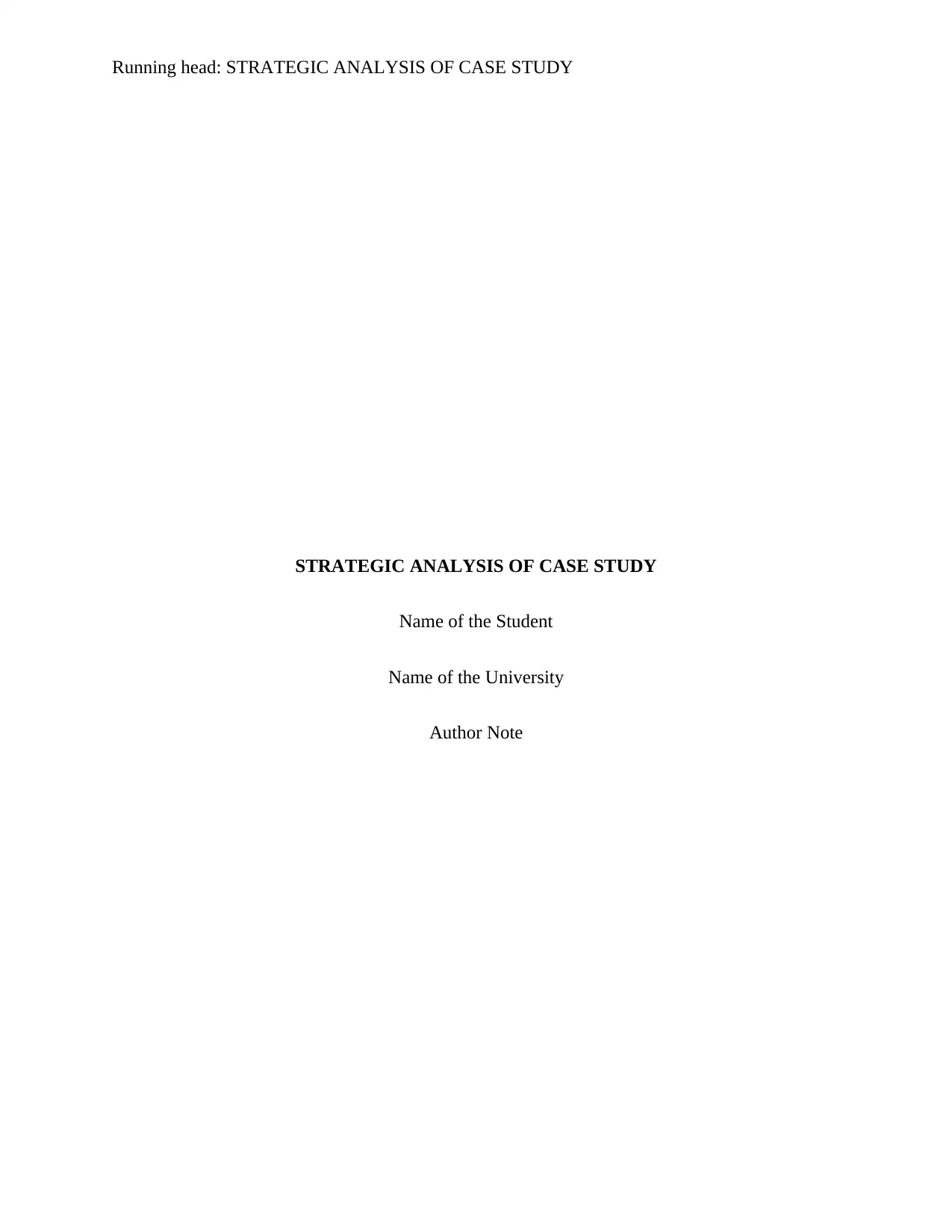
Running head: STRATEGIC ANALYSIS OF CASE STUDY
STRATEGIC ANALYSIS OF CASE STUDY
Name of the Student
Name of the University
Author Note
STRATEGIC ANALYSIS OF CASE STUDY
Name of the Student
Name of the University
Author Note
Paraphrase This Document
Need a fresh take? Get an instant paraphrase of this document with our AI Paraphraser
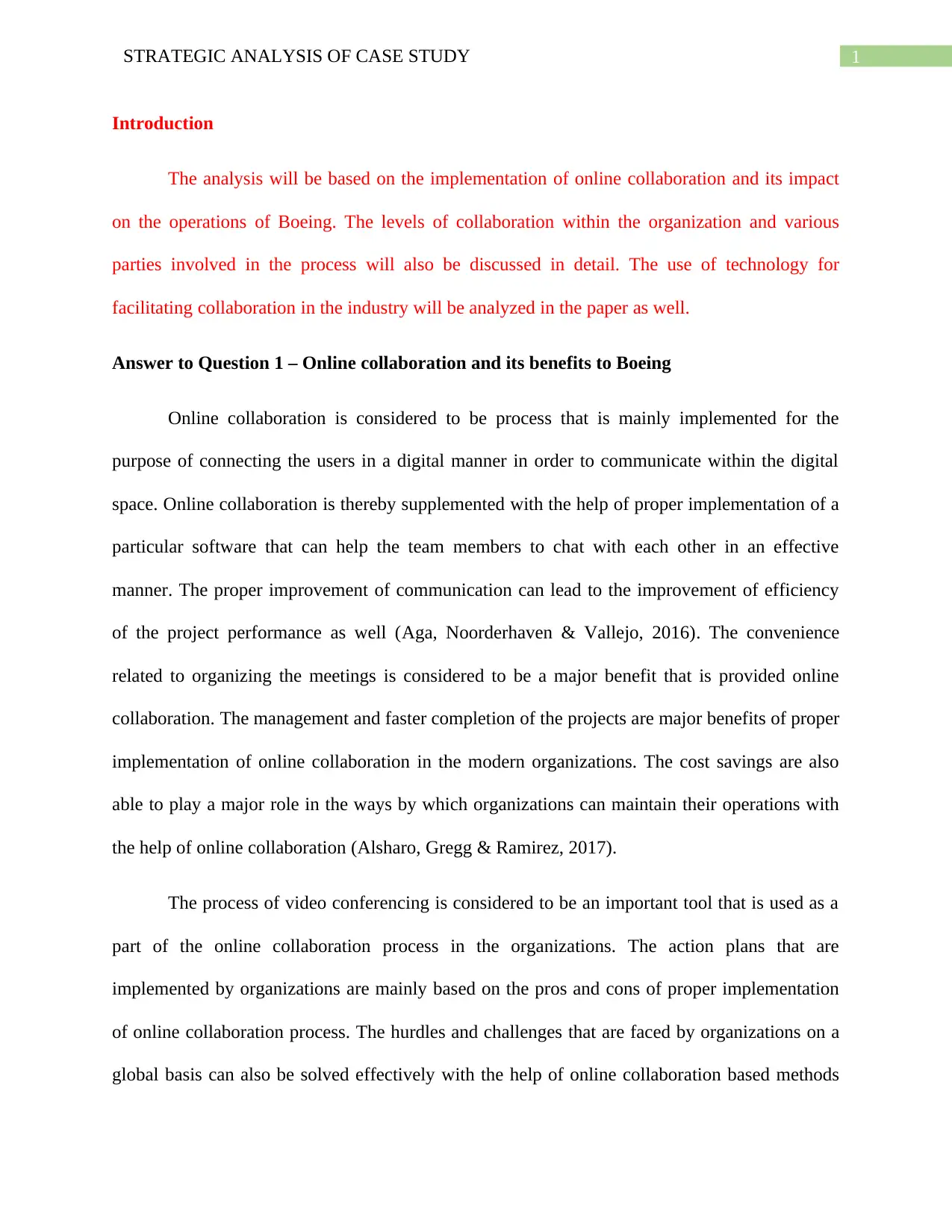
1STRATEGIC ANALYSIS OF CASE STUDY
Introduction
The analysis will be based on the implementation of online collaboration and its impact
on the operations of Boeing. The levels of collaboration within the organization and various
parties involved in the process will also be discussed in detail. The use of technology for
facilitating collaboration in the industry will be analyzed in the paper as well.
Answer to Question 1 – Online collaboration and its benefits to Boeing
Online collaboration is considered to be process that is mainly implemented for the
purpose of connecting the users in a digital manner in order to communicate within the digital
space. Online collaboration is thereby supplemented with the help of proper implementation of a
particular software that can help the team members to chat with each other in an effective
manner. The proper improvement of communication can lead to the improvement of efficiency
of the project performance as well (Aga, Noorderhaven & Vallejo, 2016). The convenience
related to organizing the meetings is considered to be a major benefit that is provided online
collaboration. The management and faster completion of the projects are major benefits of proper
implementation of online collaboration in the modern organizations. The cost savings are also
able to play a major role in the ways by which organizations can maintain their operations with
the help of online collaboration (Alsharo, Gregg & Ramirez, 2017).
The process of video conferencing is considered to be an important tool that is used as a
part of the online collaboration process in the organizations. The action plans that are
implemented by organizations are mainly based on the pros and cons of proper implementation
of online collaboration process. The hurdles and challenges that are faced by organizations on a
global basis can also be solved effectively with the help of online collaboration based methods
Introduction
The analysis will be based on the implementation of online collaboration and its impact
on the operations of Boeing. The levels of collaboration within the organization and various
parties involved in the process will also be discussed in detail. The use of technology for
facilitating collaboration in the industry will be analyzed in the paper as well.
Answer to Question 1 – Online collaboration and its benefits to Boeing
Online collaboration is considered to be process that is mainly implemented for the
purpose of connecting the users in a digital manner in order to communicate within the digital
space. Online collaboration is thereby supplemented with the help of proper implementation of a
particular software that can help the team members to chat with each other in an effective
manner. The proper improvement of communication can lead to the improvement of efficiency
of the project performance as well (Aga, Noorderhaven & Vallejo, 2016). The convenience
related to organizing the meetings is considered to be a major benefit that is provided online
collaboration. The management and faster completion of the projects are major benefits of proper
implementation of online collaboration in the modern organizations. The cost savings are also
able to play a major role in the ways by which organizations can maintain their operations with
the help of online collaboration (Alsharo, Gregg & Ramirez, 2017).
The process of video conferencing is considered to be an important tool that is used as a
part of the online collaboration process in the organizations. The action plans that are
implemented by organizations are mainly based on the pros and cons of proper implementation
of online collaboration process. The hurdles and challenges that are faced by organizations on a
global basis can also be solved effectively with the help of online collaboration based methods
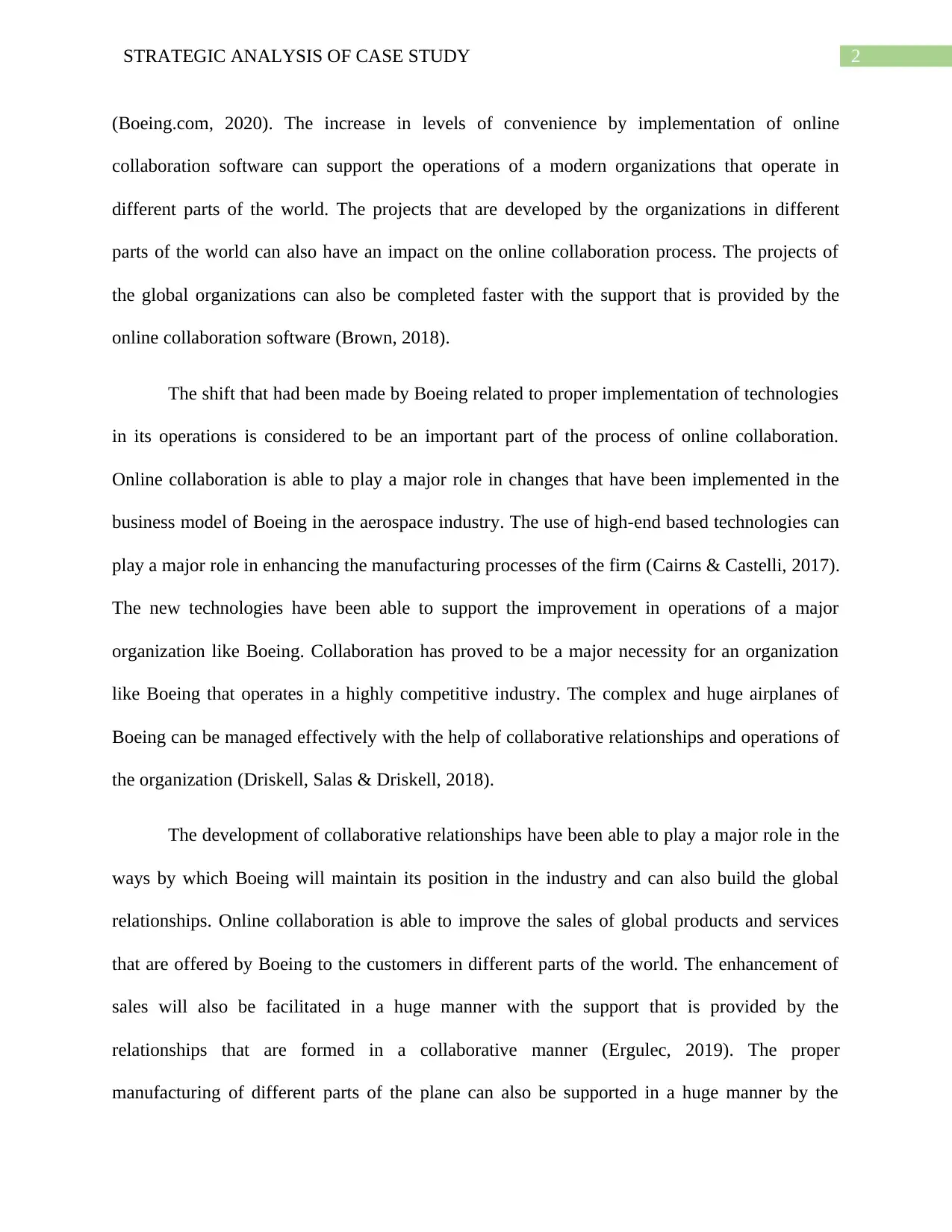
2STRATEGIC ANALYSIS OF CASE STUDY
(Boeing.com, 2020). The increase in levels of convenience by implementation of online
collaboration software can support the operations of a modern organizations that operate in
different parts of the world. The projects that are developed by the organizations in different
parts of the world can also have an impact on the online collaboration process. The projects of
the global organizations can also be completed faster with the support that is provided by the
online collaboration software (Brown, 2018).
The shift that had been made by Boeing related to proper implementation of technologies
in its operations is considered to be an important part of the process of online collaboration.
Online collaboration is able to play a major role in changes that have been implemented in the
business model of Boeing in the aerospace industry. The use of high-end based technologies can
play a major role in enhancing the manufacturing processes of the firm (Cairns & Castelli, 2017).
The new technologies have been able to support the improvement in operations of a major
organization like Boeing. Collaboration has proved to be a major necessity for an organization
like Boeing that operates in a highly competitive industry. The complex and huge airplanes of
Boeing can be managed effectively with the help of collaborative relationships and operations of
the organization (Driskell, Salas & Driskell, 2018).
The development of collaborative relationships have been able to play a major role in the
ways by which Boeing will maintain its position in the industry and can also build the global
relationships. Online collaboration is able to improve the sales of global products and services
that are offered by Boeing to the customers in different parts of the world. The enhancement of
sales will also be facilitated in a huge manner with the support that is provided by the
relationships that are formed in a collaborative manner (Ergulec, 2019). The proper
manufacturing of different parts of the plane can also be supported in a huge manner by the
(Boeing.com, 2020). The increase in levels of convenience by implementation of online
collaboration software can support the operations of a modern organizations that operate in
different parts of the world. The projects that are developed by the organizations in different
parts of the world can also have an impact on the online collaboration process. The projects of
the global organizations can also be completed faster with the support that is provided by the
online collaboration software (Brown, 2018).
The shift that had been made by Boeing related to proper implementation of technologies
in its operations is considered to be an important part of the process of online collaboration.
Online collaboration is able to play a major role in changes that have been implemented in the
business model of Boeing in the aerospace industry. The use of high-end based technologies can
play a major role in enhancing the manufacturing processes of the firm (Cairns & Castelli, 2017).
The new technologies have been able to support the improvement in operations of a major
organization like Boeing. Collaboration has proved to be a major necessity for an organization
like Boeing that operates in a highly competitive industry. The complex and huge airplanes of
Boeing can be managed effectively with the help of collaborative relationships and operations of
the organization (Driskell, Salas & Driskell, 2018).
The development of collaborative relationships have been able to play a major role in the
ways by which Boeing will maintain its position in the industry and can also build the global
relationships. Online collaboration is able to improve the sales of global products and services
that are offered by Boeing to the customers in different parts of the world. The enhancement of
sales will also be facilitated in a huge manner with the support that is provided by the
relationships that are formed in a collaborative manner (Ergulec, 2019). The proper
manufacturing of different parts of the plane can also be supported in a huge manner by the
You're viewing a preview
Unlock full access by subscribing today!
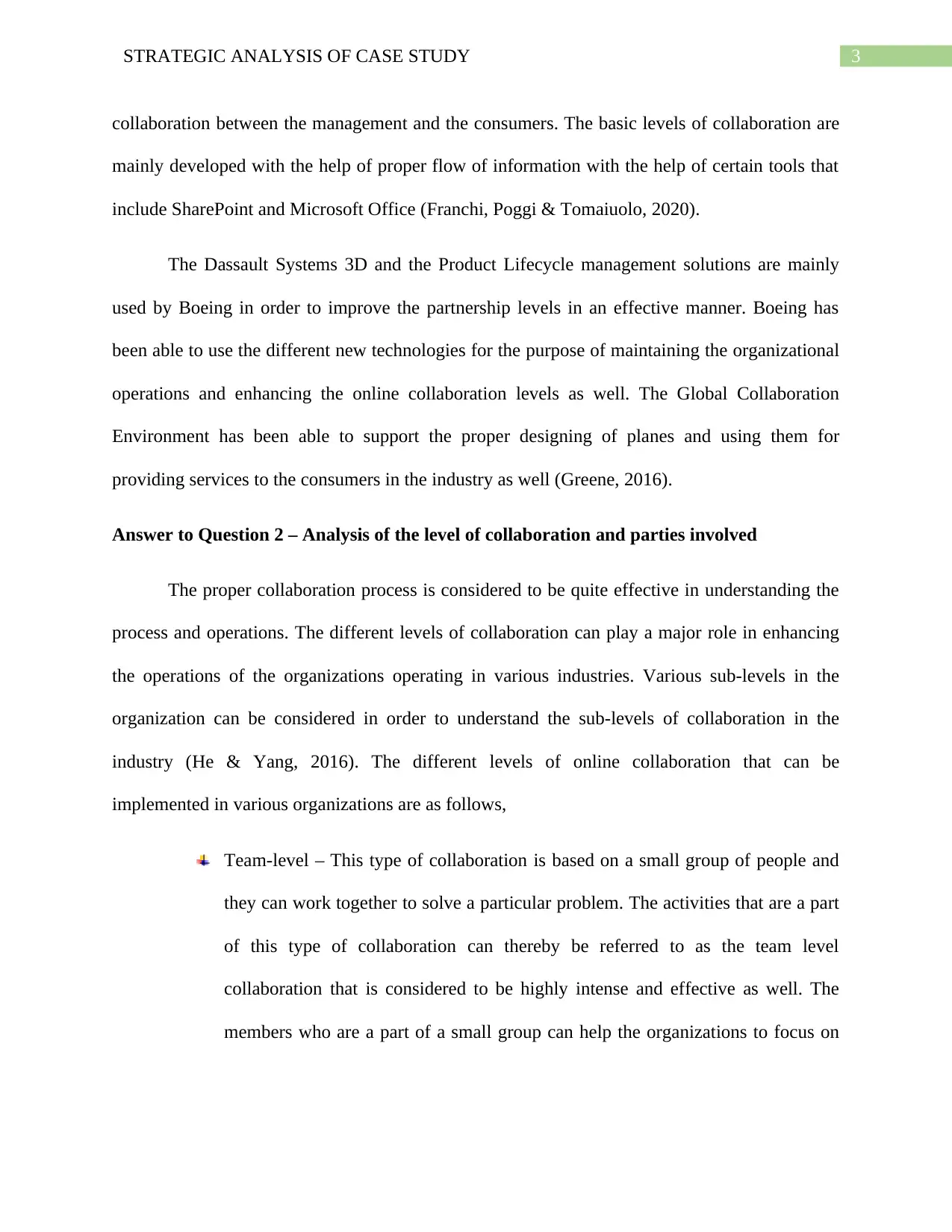
3STRATEGIC ANALYSIS OF CASE STUDY
collaboration between the management and the consumers. The basic levels of collaboration are
mainly developed with the help of proper flow of information with the help of certain tools that
include SharePoint and Microsoft Office (Franchi, Poggi & Tomaiuolo, 2020).
The Dassault Systems 3D and the Product Lifecycle management solutions are mainly
used by Boeing in order to improve the partnership levels in an effective manner. Boeing has
been able to use the different new technologies for the purpose of maintaining the organizational
operations and enhancing the online collaboration levels as well. The Global Collaboration
Environment has been able to support the proper designing of planes and using them for
providing services to the consumers in the industry as well (Greene, 2016).
Answer to Question 2 – Analysis of the level of collaboration and parties involved
The proper collaboration process is considered to be quite effective in understanding the
process and operations. The different levels of collaboration can play a major role in enhancing
the operations of the organizations operating in various industries. Various sub-levels in the
organization can be considered in order to understand the sub-levels of collaboration in the
industry (He & Yang, 2016). The different levels of online collaboration that can be
implemented in various organizations are as follows,
Team-level – This type of collaboration is based on a small group of people and
they can work together to solve a particular problem. The activities that are a part
of this type of collaboration can thereby be referred to as the team level
collaboration that is considered to be highly intense and effective as well. The
members who are a part of a small group can help the organizations to focus on
collaboration between the management and the consumers. The basic levels of collaboration are
mainly developed with the help of proper flow of information with the help of certain tools that
include SharePoint and Microsoft Office (Franchi, Poggi & Tomaiuolo, 2020).
The Dassault Systems 3D and the Product Lifecycle management solutions are mainly
used by Boeing in order to improve the partnership levels in an effective manner. Boeing has
been able to use the different new technologies for the purpose of maintaining the organizational
operations and enhancing the online collaboration levels as well. The Global Collaboration
Environment has been able to support the proper designing of planes and using them for
providing services to the consumers in the industry as well (Greene, 2016).
Answer to Question 2 – Analysis of the level of collaboration and parties involved
The proper collaboration process is considered to be quite effective in understanding the
process and operations. The different levels of collaboration can play a major role in enhancing
the operations of the organizations operating in various industries. Various sub-levels in the
organization can be considered in order to understand the sub-levels of collaboration in the
industry (He & Yang, 2016). The different levels of online collaboration that can be
implemented in various organizations are as follows,
Team-level – This type of collaboration is based on a small group of people and
they can work together to solve a particular problem. The activities that are a part
of this type of collaboration can thereby be referred to as the team level
collaboration that is considered to be highly intense and effective as well. The
members who are a part of a small group can help the organizations to focus on
Paraphrase This Document
Need a fresh take? Get an instant paraphrase of this document with our AI Paraphraser
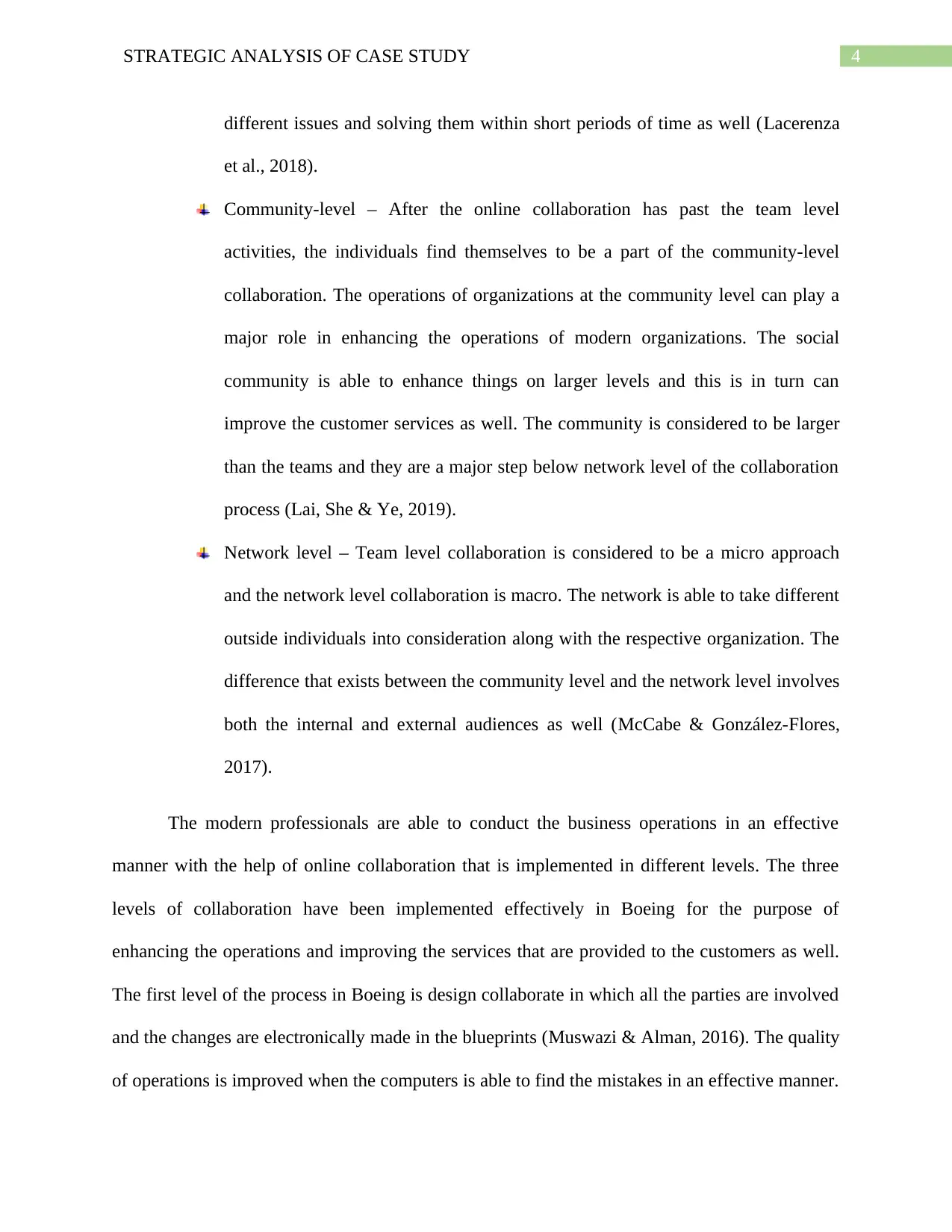
4STRATEGIC ANALYSIS OF CASE STUDY
different issues and solving them within short periods of time as well (Lacerenza
et al., 2018).
Community-level – After the online collaboration has past the team level
activities, the individuals find themselves to be a part of the community-level
collaboration. The operations of organizations at the community level can play a
major role in enhancing the operations of modern organizations. The social
community is able to enhance things on larger levels and this is in turn can
improve the customer services as well. The community is considered to be larger
than the teams and they are a major step below network level of the collaboration
process (Lai, She & Ye, 2019).
Network level – Team level collaboration is considered to be a micro approach
and the network level collaboration is macro. The network is able to take different
outside individuals into consideration along with the respective organization. The
difference that exists between the community level and the network level involves
both the internal and external audiences as well (McCabe & González-Flores,
2017).
The modern professionals are able to conduct the business operations in an effective
manner with the help of online collaboration that is implemented in different levels. The three
levels of collaboration have been implemented effectively in Boeing for the purpose of
enhancing the operations and improving the services that are provided to the customers as well.
The first level of the process in Boeing is design collaborate in which all the parties are involved
and the changes are electronically made in the blueprints (Muswazi & Alman, 2016). The quality
of operations is improved when the computers is able to find the mistakes in an effective manner.
different issues and solving them within short periods of time as well (Lacerenza
et al., 2018).
Community-level – After the online collaboration has past the team level
activities, the individuals find themselves to be a part of the community-level
collaboration. The operations of organizations at the community level can play a
major role in enhancing the operations of modern organizations. The social
community is able to enhance things on larger levels and this is in turn can
improve the customer services as well. The community is considered to be larger
than the teams and they are a major step below network level of the collaboration
process (Lai, She & Ye, 2019).
Network level – Team level collaboration is considered to be a micro approach
and the network level collaboration is macro. The network is able to take different
outside individuals into consideration along with the respective organization. The
difference that exists between the community level and the network level involves
both the internal and external audiences as well (McCabe & González-Flores,
2017).
The modern professionals are able to conduct the business operations in an effective
manner with the help of online collaboration that is implemented in different levels. The three
levels of collaboration have been implemented effectively in Boeing for the purpose of
enhancing the operations and improving the services that are provided to the customers as well.
The first level of the process in Boeing is design collaborate in which all the parties are involved
and the changes are electronically made in the blueprints (Muswazi & Alman, 2016). The quality
of operations is improved when the computers is able to find the mistakes in an effective manner.
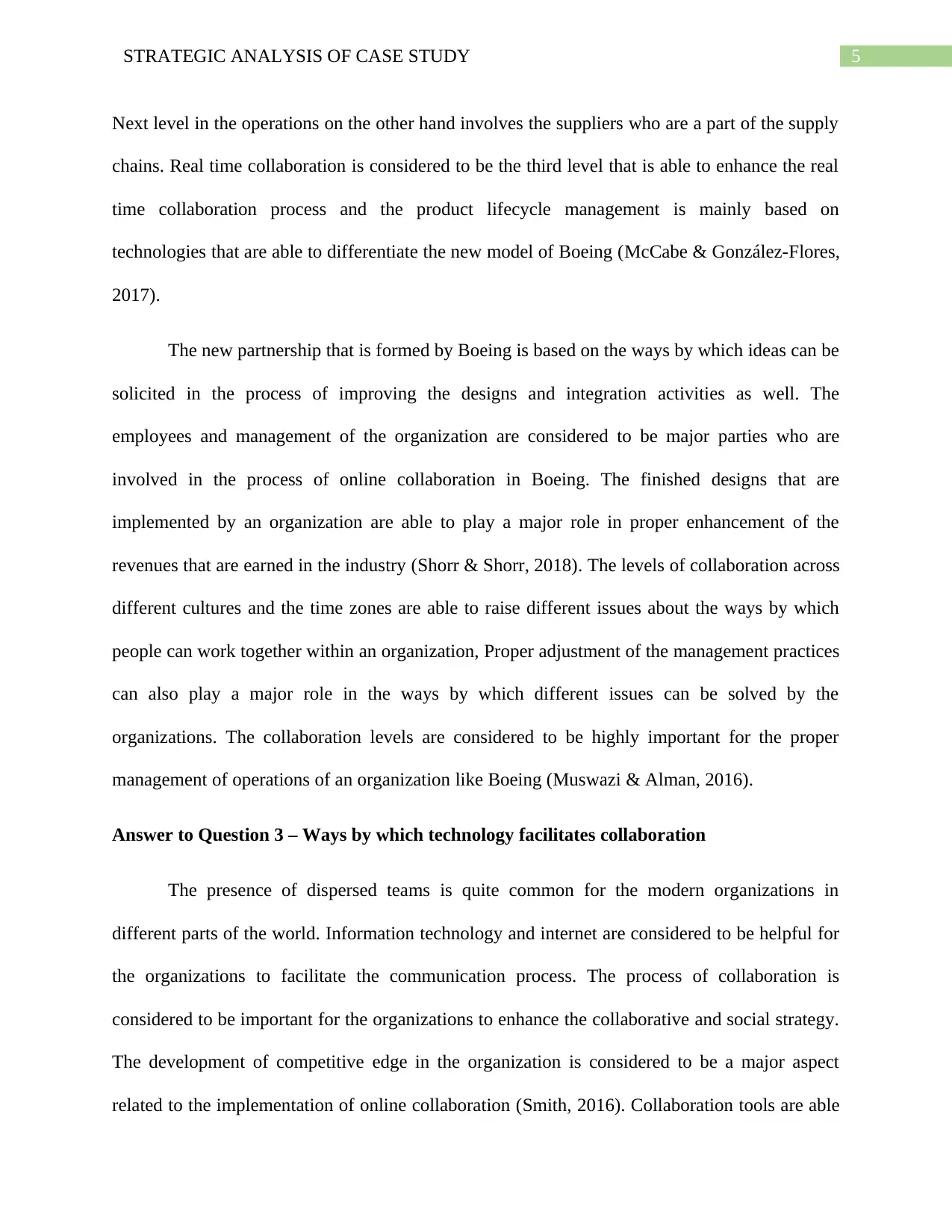
5STRATEGIC ANALYSIS OF CASE STUDY
Next level in the operations on the other hand involves the suppliers who are a part of the supply
chains. Real time collaboration is considered to be the third level that is able to enhance the real
time collaboration process and the product lifecycle management is mainly based on
technologies that are able to differentiate the new model of Boeing (McCabe & González-Flores,
2017).
The new partnership that is formed by Boeing is based on the ways by which ideas can be
solicited in the process of improving the designs and integration activities as well. The
employees and management of the organization are considered to be major parties who are
involved in the process of online collaboration in Boeing. The finished designs that are
implemented by an organization are able to play a major role in proper enhancement of the
revenues that are earned in the industry (Shorr & Shorr, 2018). The levels of collaboration across
different cultures and the time zones are able to raise different issues about the ways by which
people can work together within an organization, Proper adjustment of the management practices
can also play a major role in the ways by which different issues can be solved by the
organizations. The collaboration levels are considered to be highly important for the proper
management of operations of an organization like Boeing (Muswazi & Alman, 2016).
Answer to Question 3 – Ways by which technology facilitates collaboration
The presence of dispersed teams is quite common for the modern organizations in
different parts of the world. Information technology and internet are considered to be helpful for
the organizations to facilitate the communication process. The process of collaboration is
considered to be important for the organizations to enhance the collaborative and social strategy.
The development of competitive edge in the organization is considered to be a major aspect
related to the implementation of online collaboration (Smith, 2016). Collaboration tools are able
Next level in the operations on the other hand involves the suppliers who are a part of the supply
chains. Real time collaboration is considered to be the third level that is able to enhance the real
time collaboration process and the product lifecycle management is mainly based on
technologies that are able to differentiate the new model of Boeing (McCabe & González-Flores,
2017).
The new partnership that is formed by Boeing is based on the ways by which ideas can be
solicited in the process of improving the designs and integration activities as well. The
employees and management of the organization are considered to be major parties who are
involved in the process of online collaboration in Boeing. The finished designs that are
implemented by an organization are able to play a major role in proper enhancement of the
revenues that are earned in the industry (Shorr & Shorr, 2018). The levels of collaboration across
different cultures and the time zones are able to raise different issues about the ways by which
people can work together within an organization, Proper adjustment of the management practices
can also play a major role in the ways by which different issues can be solved by the
organizations. The collaboration levels are considered to be highly important for the proper
management of operations of an organization like Boeing (Muswazi & Alman, 2016).
Answer to Question 3 – Ways by which technology facilitates collaboration
The presence of dispersed teams is quite common for the modern organizations in
different parts of the world. Information technology and internet are considered to be helpful for
the organizations to facilitate the communication process. The process of collaboration is
considered to be important for the organizations to enhance the collaborative and social strategy.
The development of competitive edge in the organization is considered to be a major aspect
related to the implementation of online collaboration (Smith, 2016). Collaboration tools are able
You're viewing a preview
Unlock full access by subscribing today!
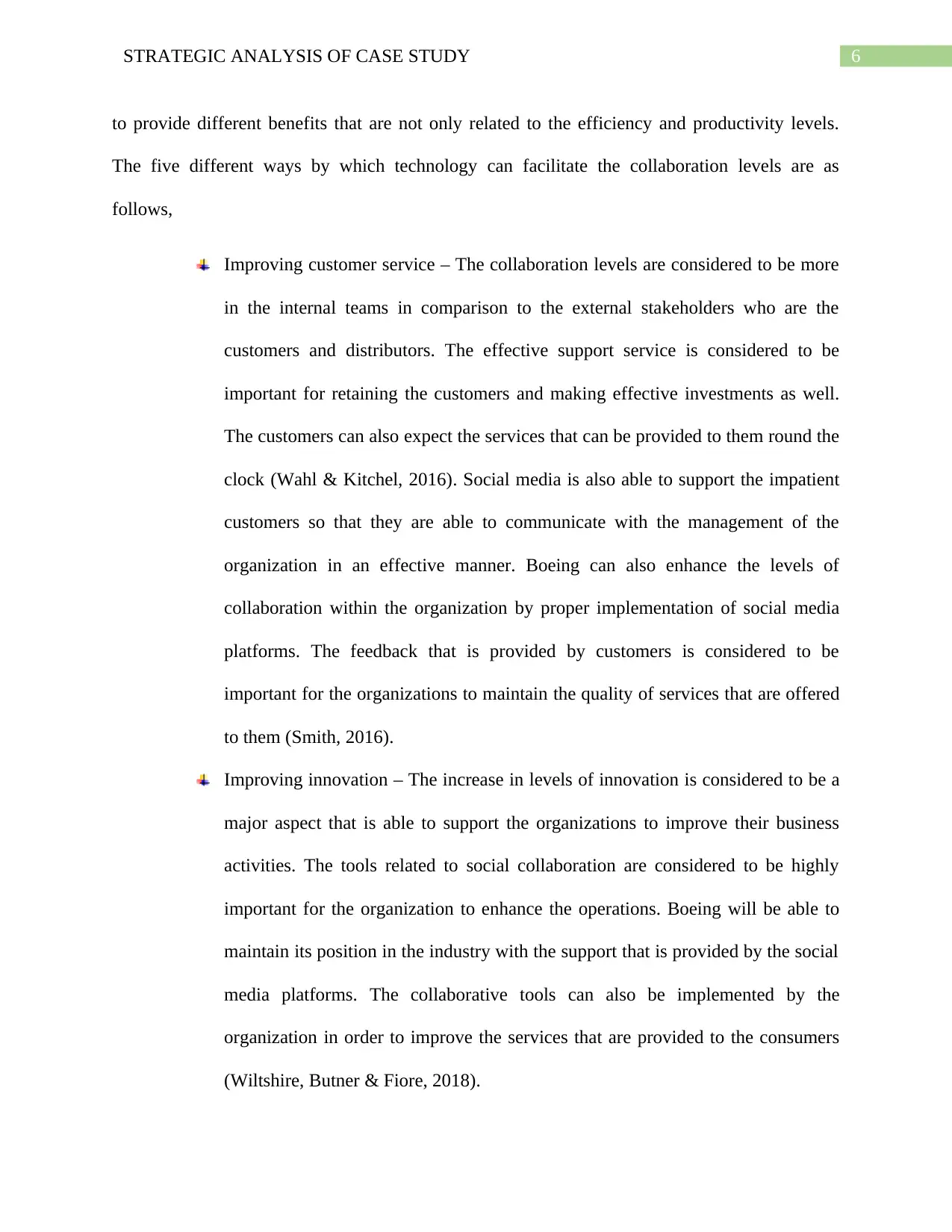
6STRATEGIC ANALYSIS OF CASE STUDY
to provide different benefits that are not only related to the efficiency and productivity levels.
The five different ways by which technology can facilitate the collaboration levels are as
follows,
Improving customer service – The collaboration levels are considered to be more
in the internal teams in comparison to the external stakeholders who are the
customers and distributors. The effective support service is considered to be
important for retaining the customers and making effective investments as well.
The customers can also expect the services that can be provided to them round the
clock (Wahl & Kitchel, 2016). Social media is also able to support the impatient
customers so that they are able to communicate with the management of the
organization in an effective manner. Boeing can also enhance the levels of
collaboration within the organization by proper implementation of social media
platforms. The feedback that is provided by customers is considered to be
important for the organizations to maintain the quality of services that are offered
to them (Smith, 2016).
Improving innovation – The increase in levels of innovation is considered to be a
major aspect that is able to support the organizations to improve their business
activities. The tools related to social collaboration are considered to be highly
important for the organization to enhance the operations. Boeing will be able to
maintain its position in the industry with the support that is provided by the social
media platforms. The collaborative tools can also be implemented by the
organization in order to improve the services that are provided to the consumers
(Wiltshire, Butner & Fiore, 2018).
to provide different benefits that are not only related to the efficiency and productivity levels.
The five different ways by which technology can facilitate the collaboration levels are as
follows,
Improving customer service – The collaboration levels are considered to be more
in the internal teams in comparison to the external stakeholders who are the
customers and distributors. The effective support service is considered to be
important for retaining the customers and making effective investments as well.
The customers can also expect the services that can be provided to them round the
clock (Wahl & Kitchel, 2016). Social media is also able to support the impatient
customers so that they are able to communicate with the management of the
organization in an effective manner. Boeing can also enhance the levels of
collaboration within the organization by proper implementation of social media
platforms. The feedback that is provided by customers is considered to be
important for the organizations to maintain the quality of services that are offered
to them (Smith, 2016).
Improving innovation – The increase in levels of innovation is considered to be a
major aspect that is able to support the organizations to improve their business
activities. The tools related to social collaboration are considered to be highly
important for the organization to enhance the operations. Boeing will be able to
maintain its position in the industry with the support that is provided by the social
media platforms. The collaborative tools can also be implemented by the
organization in order to improve the services that are provided to the consumers
(Wiltshire, Butner & Fiore, 2018).
Paraphrase This Document
Need a fresh take? Get an instant paraphrase of this document with our AI Paraphraser
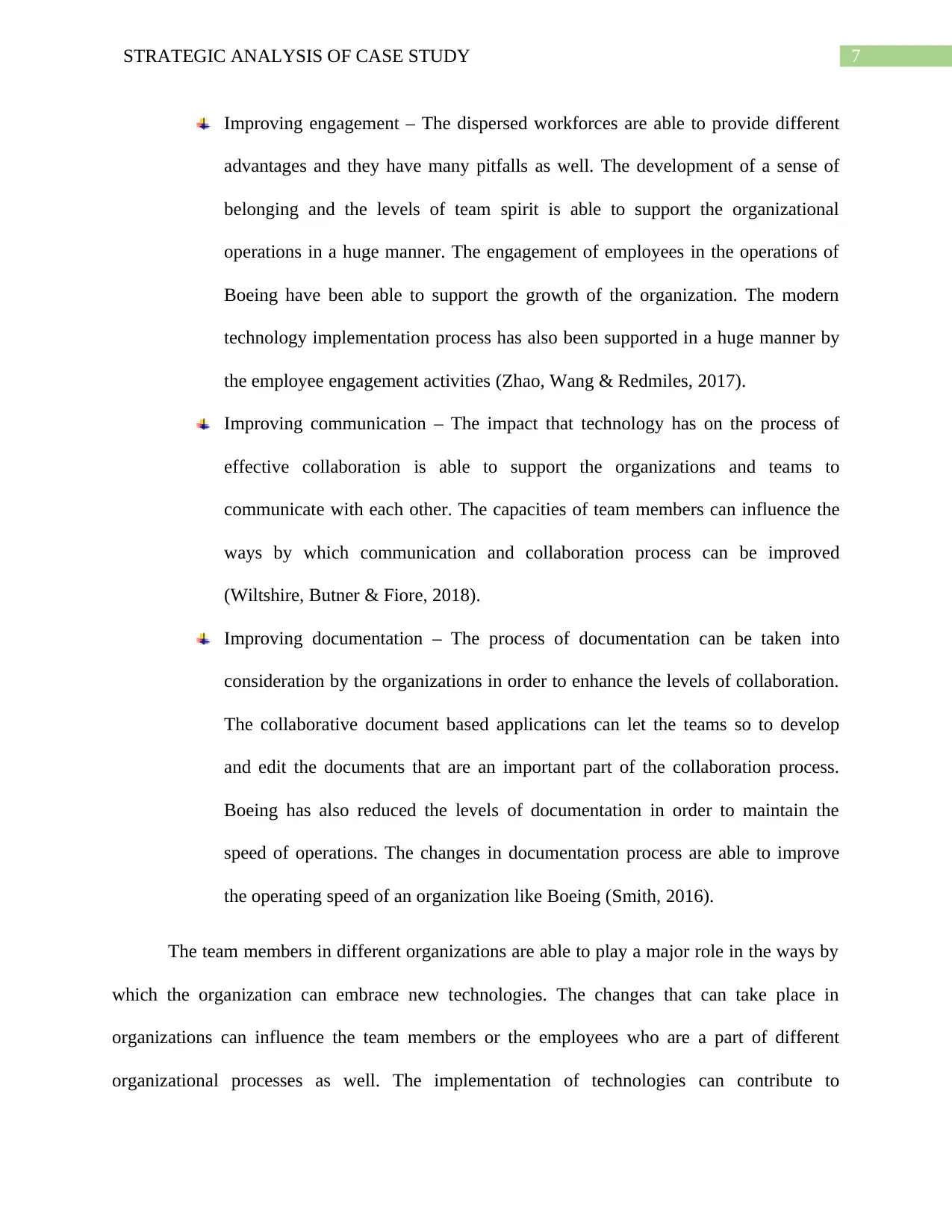
7STRATEGIC ANALYSIS OF CASE STUDY
Improving engagement – The dispersed workforces are able to provide different
advantages and they have many pitfalls as well. The development of a sense of
belonging and the levels of team spirit is able to support the organizational
operations in a huge manner. The engagement of employees in the operations of
Boeing have been able to support the growth of the organization. The modern
technology implementation process has also been supported in a huge manner by
the employee engagement activities (Zhao, Wang & Redmiles, 2017).
Improving communication – The impact that technology has on the process of
effective collaboration is able to support the organizations and teams to
communicate with each other. The capacities of team members can influence the
ways by which communication and collaboration process can be improved
(Wiltshire, Butner & Fiore, 2018).
Improving documentation – The process of documentation can be taken into
consideration by the organizations in order to enhance the levels of collaboration.
The collaborative document based applications can let the teams so to develop
and edit the documents that are an important part of the collaboration process.
Boeing has also reduced the levels of documentation in order to maintain the
speed of operations. The changes in documentation process are able to improve
the operating speed of an organization like Boeing (Smith, 2016).
The team members in different organizations are able to play a major role in the ways by
which the organization can embrace new technologies. The changes that can take place in
organizations can influence the team members or the employees who are a part of different
organizational processes as well. The implementation of technologies can contribute to
Improving engagement – The dispersed workforces are able to provide different
advantages and they have many pitfalls as well. The development of a sense of
belonging and the levels of team spirit is able to support the organizational
operations in a huge manner. The engagement of employees in the operations of
Boeing have been able to support the growth of the organization. The modern
technology implementation process has also been supported in a huge manner by
the employee engagement activities (Zhao, Wang & Redmiles, 2017).
Improving communication – The impact that technology has on the process of
effective collaboration is able to support the organizations and teams to
communicate with each other. The capacities of team members can influence the
ways by which communication and collaboration process can be improved
(Wiltshire, Butner & Fiore, 2018).
Improving documentation – The process of documentation can be taken into
consideration by the organizations in order to enhance the levels of collaboration.
The collaborative document based applications can let the teams so to develop
and edit the documents that are an important part of the collaboration process.
Boeing has also reduced the levels of documentation in order to maintain the
speed of operations. The changes in documentation process are able to improve
the operating speed of an organization like Boeing (Smith, 2016).
The team members in different organizations are able to play a major role in the ways by
which the organization can embrace new technologies. The changes that can take place in
organizations can influence the team members or the employees who are a part of different
organizational processes as well. The implementation of technologies can contribute to
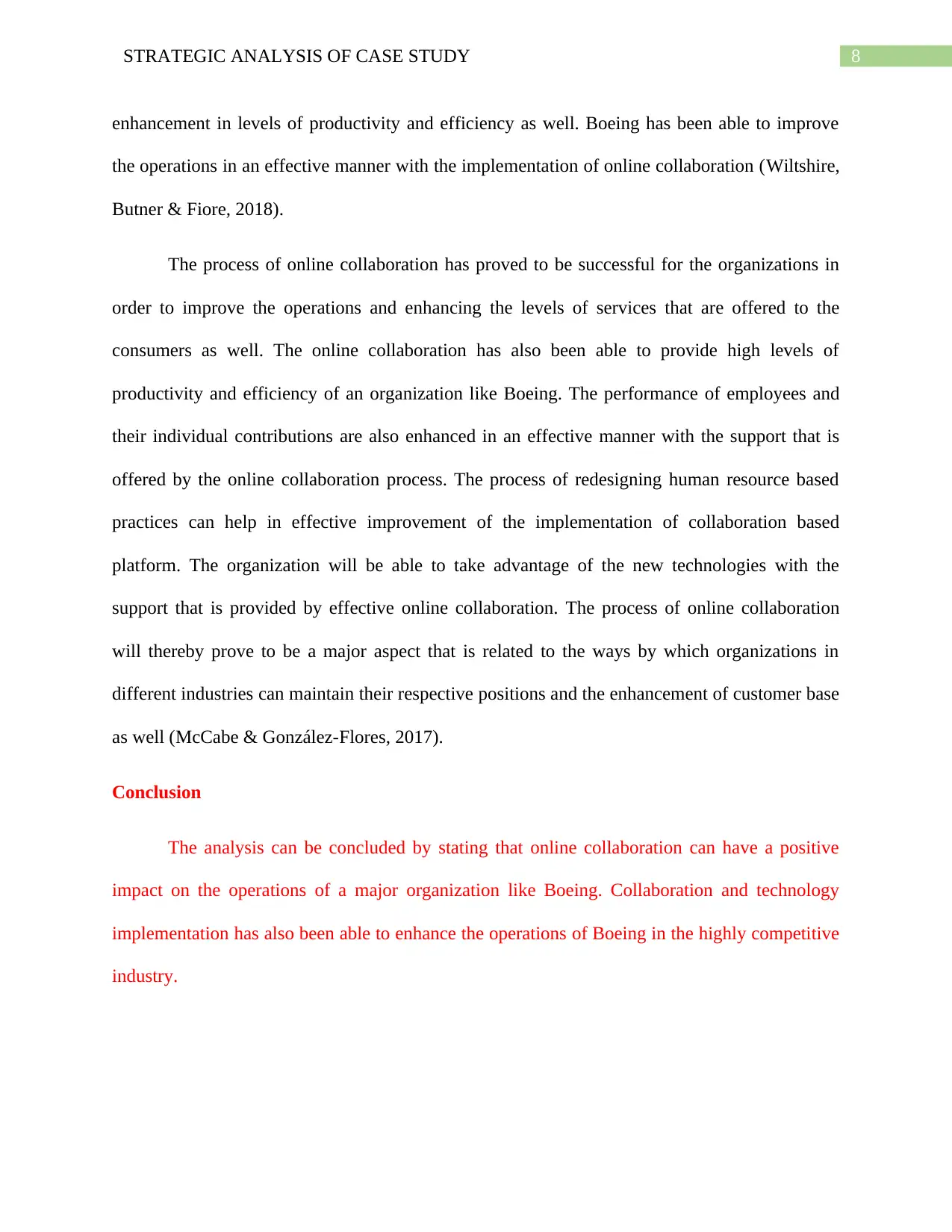
8STRATEGIC ANALYSIS OF CASE STUDY
enhancement in levels of productivity and efficiency as well. Boeing has been able to improve
the operations in an effective manner with the implementation of online collaboration (Wiltshire,
Butner & Fiore, 2018).
The process of online collaboration has proved to be successful for the organizations in
order to improve the operations and enhancing the levels of services that are offered to the
consumers as well. The online collaboration has also been able to provide high levels of
productivity and efficiency of an organization like Boeing. The performance of employees and
their individual contributions are also enhanced in an effective manner with the support that is
offered by the online collaboration process. The process of redesigning human resource based
practices can help in effective improvement of the implementation of collaboration based
platform. The organization will be able to take advantage of the new technologies with the
support that is provided by effective online collaboration. The process of online collaboration
will thereby prove to be a major aspect that is related to the ways by which organizations in
different industries can maintain their respective positions and the enhancement of customer base
as well (McCabe & González-Flores, 2017).
Conclusion
The analysis can be concluded by stating that online collaboration can have a positive
impact on the operations of a major organization like Boeing. Collaboration and technology
implementation has also been able to enhance the operations of Boeing in the highly competitive
industry.
enhancement in levels of productivity and efficiency as well. Boeing has been able to improve
the operations in an effective manner with the implementation of online collaboration (Wiltshire,
Butner & Fiore, 2018).
The process of online collaboration has proved to be successful for the organizations in
order to improve the operations and enhancing the levels of services that are offered to the
consumers as well. The online collaboration has also been able to provide high levels of
productivity and efficiency of an organization like Boeing. The performance of employees and
their individual contributions are also enhanced in an effective manner with the support that is
offered by the online collaboration process. The process of redesigning human resource based
practices can help in effective improvement of the implementation of collaboration based
platform. The organization will be able to take advantage of the new technologies with the
support that is provided by effective online collaboration. The process of online collaboration
will thereby prove to be a major aspect that is related to the ways by which organizations in
different industries can maintain their respective positions and the enhancement of customer base
as well (McCabe & González-Flores, 2017).
Conclusion
The analysis can be concluded by stating that online collaboration can have a positive
impact on the operations of a major organization like Boeing. Collaboration and technology
implementation has also been able to enhance the operations of Boeing in the highly competitive
industry.
You're viewing a preview
Unlock full access by subscribing today!
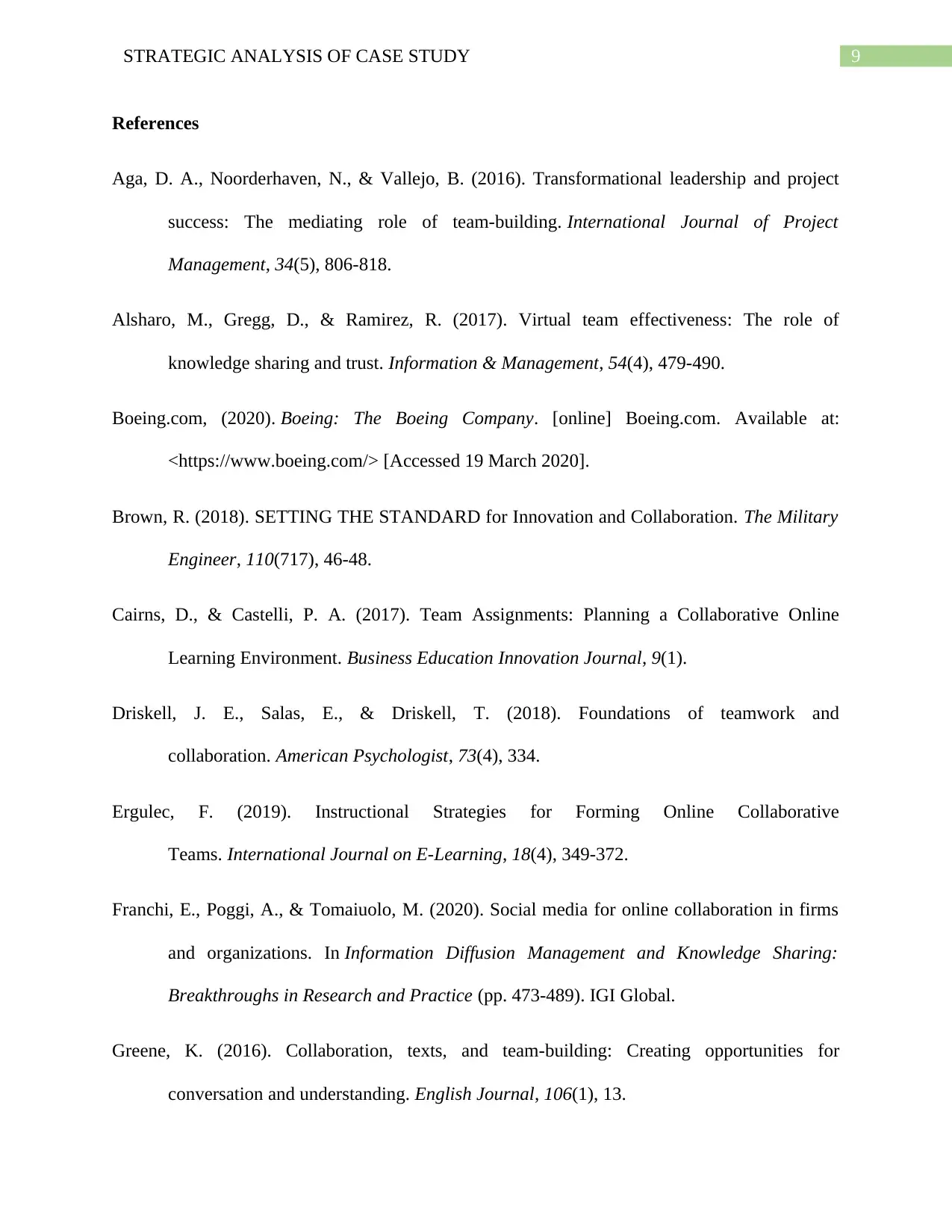
9STRATEGIC ANALYSIS OF CASE STUDY
References
Aga, D. A., Noorderhaven, N., & Vallejo, B. (2016). Transformational leadership and project
success: The mediating role of team-building. International Journal of Project
Management, 34(5), 806-818.
Alsharo, M., Gregg, D., & Ramirez, R. (2017). Virtual team effectiveness: The role of
knowledge sharing and trust. Information & Management, 54(4), 479-490.
Boeing.com, (2020). Boeing: The Boeing Company. [online] Boeing.com. Available at:
<https://www.boeing.com/> [Accessed 19 March 2020].
Brown, R. (2018). SETTING THE STANDARD for Innovation and Collaboration. The Military
Engineer, 110(717), 46-48.
Cairns, D., & Castelli, P. A. (2017). Team Assignments: Planning a Collaborative Online
Learning Environment. Business Education Innovation Journal, 9(1).
Driskell, J. E., Salas, E., & Driskell, T. (2018). Foundations of teamwork and
collaboration. American Psychologist, 73(4), 334.
Ergulec, F. (2019). Instructional Strategies for Forming Online Collaborative
Teams. International Journal on E-Learning, 18(4), 349-372.
Franchi, E., Poggi, A., & Tomaiuolo, M. (2020). Social media for online collaboration in firms
and organizations. In Information Diffusion Management and Knowledge Sharing:
Breakthroughs in Research and Practice (pp. 473-489). IGI Global.
Greene, K. (2016). Collaboration, texts, and team-building: Creating opportunities for
conversation and understanding. English Journal, 106(1), 13.
References
Aga, D. A., Noorderhaven, N., & Vallejo, B. (2016). Transformational leadership and project
success: The mediating role of team-building. International Journal of Project
Management, 34(5), 806-818.
Alsharo, M., Gregg, D., & Ramirez, R. (2017). Virtual team effectiveness: The role of
knowledge sharing and trust. Information & Management, 54(4), 479-490.
Boeing.com, (2020). Boeing: The Boeing Company. [online] Boeing.com. Available at:
<https://www.boeing.com/> [Accessed 19 March 2020].
Brown, R. (2018). SETTING THE STANDARD for Innovation and Collaboration. The Military
Engineer, 110(717), 46-48.
Cairns, D., & Castelli, P. A. (2017). Team Assignments: Planning a Collaborative Online
Learning Environment. Business Education Innovation Journal, 9(1).
Driskell, J. E., Salas, E., & Driskell, T. (2018). Foundations of teamwork and
collaboration. American Psychologist, 73(4), 334.
Ergulec, F. (2019). Instructional Strategies for Forming Online Collaborative
Teams. International Journal on E-Learning, 18(4), 349-372.
Franchi, E., Poggi, A., & Tomaiuolo, M. (2020). Social media for online collaboration in firms
and organizations. In Information Diffusion Management and Knowledge Sharing:
Breakthroughs in Research and Practice (pp. 473-489). IGI Global.
Greene, K. (2016). Collaboration, texts, and team-building: Creating opportunities for
conversation and understanding. English Journal, 106(1), 13.
Paraphrase This Document
Need a fresh take? Get an instant paraphrase of this document with our AI Paraphraser
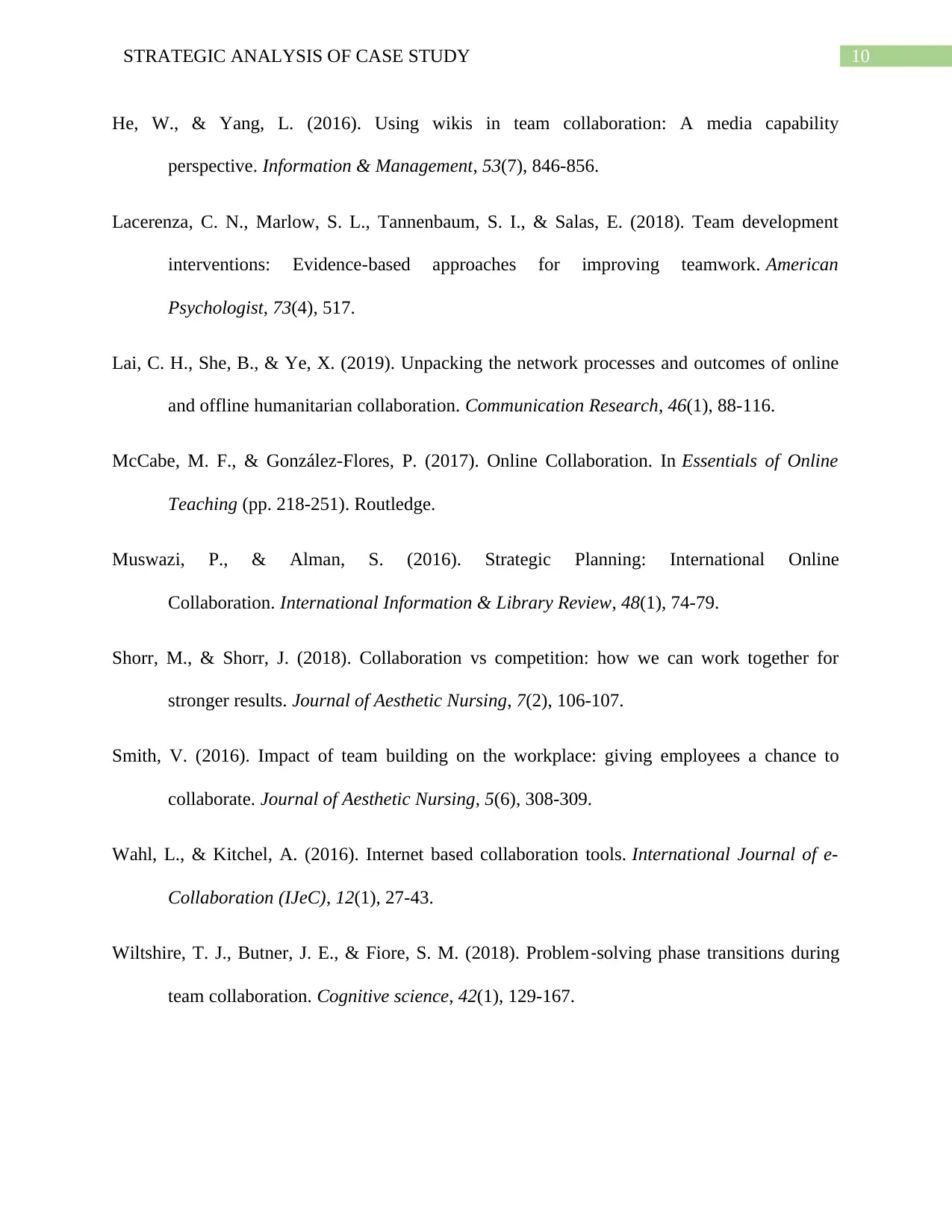
10STRATEGIC ANALYSIS OF CASE STUDY
He, W., & Yang, L. (2016). Using wikis in team collaboration: A media capability
perspective. Information & Management, 53(7), 846-856.
Lacerenza, C. N., Marlow, S. L., Tannenbaum, S. I., & Salas, E. (2018). Team development
interventions: Evidence-based approaches for improving teamwork. American
Psychologist, 73(4), 517.
Lai, C. H., She, B., & Ye, X. (2019). Unpacking the network processes and outcomes of online
and offline humanitarian collaboration. Communication Research, 46(1), 88-116.
McCabe, M. F., & González-Flores, P. (2017). Online Collaboration. In Essentials of Online
Teaching (pp. 218-251). Routledge.
Muswazi, P., & Alman, S. (2016). Strategic Planning: International Online
Collaboration. International Information & Library Review, 48(1), 74-79.
Shorr, M., & Shorr, J. (2018). Collaboration vs competition: how we can work together for
stronger results. Journal of Aesthetic Nursing, 7(2), 106-107.
Smith, V. (2016). Impact of team building on the workplace: giving employees a chance to
collaborate. Journal of Aesthetic Nursing, 5(6), 308-309.
Wahl, L., & Kitchel, A. (2016). Internet based collaboration tools. International Journal of e-
Collaboration (IJeC), 12(1), 27-43.
Wiltshire, T. J., Butner, J. E., & Fiore, S. M. (2018). Problem‐solving phase transitions during
team collaboration. Cognitive science, 42(1), 129-167.
He, W., & Yang, L. (2016). Using wikis in team collaboration: A media capability
perspective. Information & Management, 53(7), 846-856.
Lacerenza, C. N., Marlow, S. L., Tannenbaum, S. I., & Salas, E. (2018). Team development
interventions: Evidence-based approaches for improving teamwork. American
Psychologist, 73(4), 517.
Lai, C. H., She, B., & Ye, X. (2019). Unpacking the network processes and outcomes of online
and offline humanitarian collaboration. Communication Research, 46(1), 88-116.
McCabe, M. F., & González-Flores, P. (2017). Online Collaboration. In Essentials of Online
Teaching (pp. 218-251). Routledge.
Muswazi, P., & Alman, S. (2016). Strategic Planning: International Online
Collaboration. International Information & Library Review, 48(1), 74-79.
Shorr, M., & Shorr, J. (2018). Collaboration vs competition: how we can work together for
stronger results. Journal of Aesthetic Nursing, 7(2), 106-107.
Smith, V. (2016). Impact of team building on the workplace: giving employees a chance to
collaborate. Journal of Aesthetic Nursing, 5(6), 308-309.
Wahl, L., & Kitchel, A. (2016). Internet based collaboration tools. International Journal of e-
Collaboration (IJeC), 12(1), 27-43.
Wiltshire, T. J., Butner, J. E., & Fiore, S. M. (2018). Problem‐solving phase transitions during
team collaboration. Cognitive science, 42(1), 129-167.

11STRATEGIC ANALYSIS OF CASE STUDY
Zhao, M., Wang, Y., & Redmiles, D. (2017, May). Using collaborative online drawing to build
up distributed teams. In 2017 IEEE 12th International Conference on Global Software
Engineering (ICGSE) (pp. 61-65). IEEE.
Zhao, M., Wang, Y., & Redmiles, D. (2017, May). Using collaborative online drawing to build
up distributed teams. In 2017 IEEE 12th International Conference on Global Software
Engineering (ICGSE) (pp. 61-65). IEEE.
You're viewing a preview
Unlock full access by subscribing today!
1 out of 12
Related Documents
Your All-in-One AI-Powered Toolkit for Academic Success.
+13062052269
info@desklib.com
Available 24*7 on WhatsApp / Email
![[object Object]](/_next/static/media/star-bottom.7253800d.svg)
Unlock your academic potential
© 2024 | Zucol Services PVT LTD | All rights reserved.




